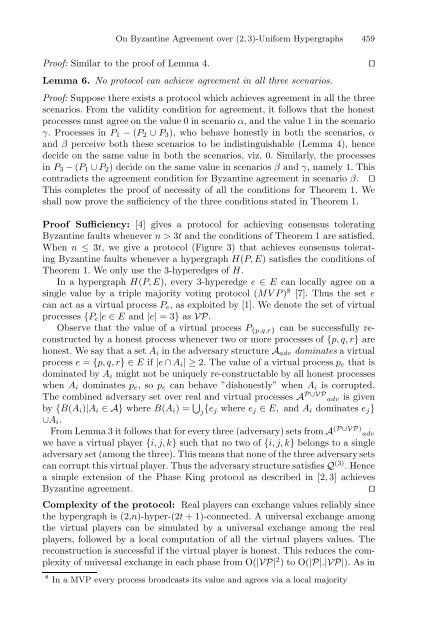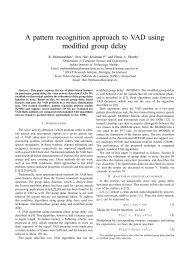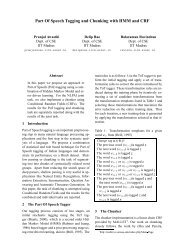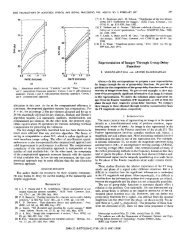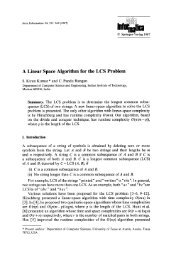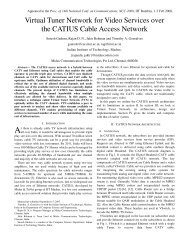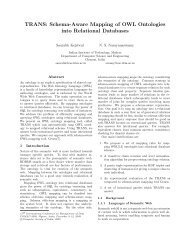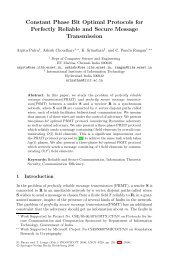On Byzantine Agreement over (2,3)-Uniform ... - Cornell University
On Byzantine Agreement over (2,3)-Uniform ... - Cornell University
On Byzantine Agreement over (2,3)-Uniform ... - Cornell University
Create successful ePaper yourself
Turn your PDF publications into a flip-book with our unique Google optimized e-Paper software.
<strong>On</strong> <strong>Byzantine</strong> <strong>Agreement</strong> <strong>over</strong> (2, 3)-<strong>Uniform</strong> Hypergraphs 459<br />
Proof: Similar to the proof of Lemma 4.<br />
Lemma 6. No protocol can achieve agreement in all three scenarios.<br />
Proof: Suppose there exists a protocol which achieves agreement in all the three<br />
scenarios. From the validity condition for agreement, it follows that the honest<br />
processes must agree on the value 0 in scenario α, and the value 1 in the scenario<br />
γ. Processes in P 1 − (P 2 ∪ P 3 ), who behave honestly in both the scenarios, α<br />
and β perceive both these scenarios to be indistinguishable (Lemma 4), hence<br />
decide on the same value in both the scenarios, viz, 0. Similarly, the processes<br />
in P 3 − (P 1 ∪ P 2 ) decide on the same value in scenarios β and γ, namely1.This<br />
contradicts the agreement condition for <strong>Byzantine</strong> agreement in scenario β. ⊓⊔<br />
This completes the proof of necessity of all the conditions for Theorem 1. We<br />
shall now prove the sufficiency of the three conditions stated in Theorem 1.<br />
Proof Sufficiency: [4] gives a protocol for achieving consensus tolerating<br />
<strong>Byzantine</strong> faults whenever n>3t and the conditions of Theorem 1 are satisfied.<br />
When n ≤ 3t, we give a protocol (Figure 3) that achieves consensus tolerating<br />
<strong>Byzantine</strong> faults whenever a hypergraph H(P, E) satisfies the conditions of<br />
Theorem 1. We only use the 3-hyperedges of H.<br />
In a hypergraph H(P, E), every 3-hyperedge e ∈ E can locally agree on a<br />
single value by a triple majority voting protocol (MVP) 8 [7]. Thus the set e<br />
can act as a virtual process P e , as exploited by [1]. We denote the set of virtual<br />
processes {P e |e ∈ E and |e| =3} as VP.<br />
Observe that the value of a virtual process P {p,q,r} can be successfully reconstructed<br />
by a honest process whenever two or more processes of {p, q, r} are<br />
honest. We say that a set A i in the adversary structure A adv dominates avirtual<br />
process e = {p, q, r} ∈E if |e ∩ A i |≥2. The value of a virtual process p e that is<br />
dominated by A i might not be uniquely re-constructable by all honest processes<br />
when A i dominates p e ,sop e can behave ”dishonestly” when A i is corrupted.<br />
The combined adversary set <strong>over</strong> real and virtual processes A P∪VP adv is given<br />
by {B(A i )|A i ∈A}where B(A i )= ⋃ j {e j where e j ∈ E, and A i dominates e j }<br />
∪A i .<br />
From Lemma 3 it follows that for every three (adversary) sets from A (P∪VP) adv<br />
we have a virtual player {i, j, k} such that no two of {i, j, k} belongs to a single<br />
adversary set (among the three). This means that none of the three adversary sets<br />
can corrupt this virtual player. Thus the adversary structure satisfies Q (3) . Hence<br />
a simple extension of the Phase King protocol as described in [2, 3] achieves<br />
<strong>Byzantine</strong> agreement.<br />
⊓⊔<br />
Complexity of the protocol: Real players can exchange values reliably since<br />
the hypergraph is (2,n)-hyper-(2t + 1)-connected. A universal exchange among<br />
the virtual players can be simulated by a universal exchange among the real<br />
players, followed by a local computation of all the virtual players values. The<br />
reconstruction is successful if the virtual player is honest. This reduces the complexity<br />
of universal exchange in each phase from O(|VP| 2 )toO(|P|.|VP|). As in<br />
8 In a MVP every process broadcasts its value and agrees via a local majority<br />
⊓⊔


